THE FUNDAMENTAL FLAWS IN THE ORION-GIZA CORRELATION THEORY
© Ian Lawton 2000
Introduction
In Chapter 9 of Giza: The Truth, Chris Ogilvie-Herald and I laid out a full analysis of the various stellar alignment and correlation theories put forward concerning the Giza Plateau. One of the most celebrated of these is the so-called Orion Correlation Theory primarily proposed by Robert Bauval, which in its most basic form suggests that the three main Giza Pyramids were laid out to reflect the three belt stars of the Orion constellation. There are two further developments to this theory - one that there is a broader correlation between major pyramids at other sites and other stars in Orion and Taurus, and the other that certain astronomical calculations indicate that this layout reflects the position of the stars at 10,500 BC. We provide a number of arguments against these two further propositions in the book, but in essence if the basic theory of correlation is inherently flawed then these additional aspects become largely irrelevant.
I have argued in previous correspondence with Robert, reproduced on my web site, that there are two fundamental flaws to the basic correlation theory. The first concerns a complete mismatch between the relative sizes of the pyramids and stars. The second the compulsive evidence of extensive replanning of the Second and Third Pyramids which strongly suggests that they could not have been constructed to a preconceived master plan. A quick perusal of our correspondence reveals that, although he was quite happy to discuss the dating aspects of his theory with me, Robert refused to be drawn into defending his basic theory against these two fundamental objections.
However, because it seems that few people have yet picked up on this new aspect of the debate, and because the theory has once again come to prominence as a result of the BSC's recent decision to uphold Robert and Graham Hancock's complaints against the Horizon programme (specifically in relation to this theory only), I have decided to reproduce the relevant extracts from Giza: The Truth in this paper, and also to elaborate on certain aspects in the hope of making the logic of my case that much clearer.
The Relative Sizes of the Stars and Pyramids
In Figure 1 I have superimposed the outline of the three Giza Pyramids onto a magnified photograph of the belt stars, scaling it so that the centre points of the two larger pyramids line up on the centres of the two stars they are supposed to represent. We can immediately see that both sets of three objects are relatively equidistant, so the general scale of this localised mapping does not present a problem. We can also see that the offset of the Third Pyramid, although not completely accurate, is in the right direction and is no further off than one would expect given the fact that the ancient Egyptians did not - at least we assume - have magnification telescopes. Furthermore this offset is clearly visible with the naked eye.
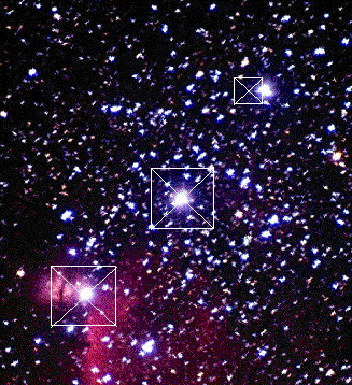
Figure 1: The Giza Pyramids Mapped onto the Belt Stars of Orion
However there is a problem when we come to the relative sizes. Mintaka, the uppermost star which is supposed to represent the smaller Third Pyramid, is not noticeably smaller than its two counterparts when viewed with the naked eye, nor even in the magnified photograph I have used in Figure 1.[i] Just to check this point I consulted the star catalogues and established the "visual magnitude” or brightness of the three stars - which is the key issue here since it correlates with observation with the naked eye and ignores the stars’ distance from Earth.[ii] Remembering that the lower the magnitude index the brighter the star, we can see from the data in the table below [iii] that in fact Al Nilam, the Second Pyramid equivalent, is the brightest of the three, and is more or less the same amount brighter than Al Nitak, the Great Pyramid equivalent, as the latter is than Mintaka. These figures are not easy to compare in percentage terms because a jump of one unit of magnitude produces a change in brightness of 2.5 times. However to the extent these variations are visible, they do not reveal Mintaka as substantially smaller than the other two - and certainly not 80 per cent smaller, as the Third Pyramid’s base area is compared to its two larger counterparts.
| Pyramid | Star | Visual Magnitude |
|---|---|---|
| Great Pyramid | Al Nitak or zeta Orionis | 2.05 |
| Second Pyramid | Al Nilam or epsilon Orionis | 1.70 |
| Third Pyramid | Mintaka or delta Orionis | 2.23 |
Whilst it is true that the undoubtedly advanced esoteric symbolism of the ancient Egyptians would not require total accuracy in the reproduction of the "above" in the "below", this is surely far too large a discrepancy to be written off to artistic licence.
The Replanning of the Pyramids
The foregoing notwithstanding, undoubtedly the most damning objection to the basic Orion Correlation Theory is the evidence of the replanning of the Second and Third Pyramids. (Note that although there is also considerable evidence of replanning in the Great Pyramid, none of this suggests a change to its size or position.)
If we examine the layout of the Third Pyramid first, there is highly compelling evidence of a major redesign. It has two descending passages, the "original" of which comes to a dead-end right underneath the superstructure (and, perhaps surprisingly, was found by Howard Vyse to have even been sealed with blocks), and would have led to the "original" main chamber, the floor of which would probably have been higher (see Figure 2). It would then appear that at some point the architects decided to increase the size of the edifice, and probably lowered the floor of this upper chamber to assist the "replanned" descending passage to still emerge on the outside near the base, as well as constructing a "replanned" lower chamber to act as the main burial room. In this case, rather than any possibility of wholesale repositioning, there was clearly an increase in size about the same centre point because even the redesigned chambers remained under the apex. The original planned superstructure would probably have occupied only about one quarter of the base area.
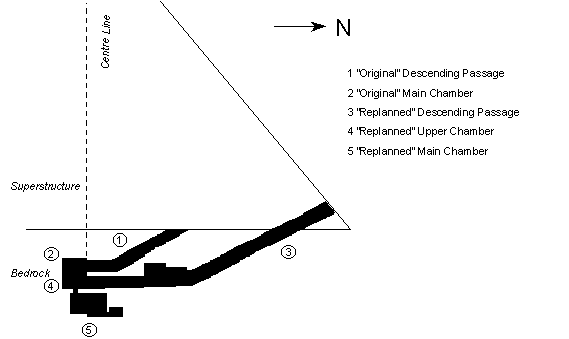
Figure 2: The Third Pyramid in Profile
This argument is certainly supported by renowned Egyptologist Professor IES Edwards, in his The Pyramids of Egypt:[iv]
Internally, at least one and probably two changes of plan are apparent. The first design consisted of a sloping corridor of the usual kind tunnelled through the rock and leading to a rectangular burial-chamber, the longer axis of which ran from east to west. When this design was abandoned the floor of the burial-chamber was deepened and a second sloping corridor cut beneath the first. The only reason for this change of plan seems to have been a decision to enlarge the superstructure of the pyramid and the consequent necessity for constructing the corridor at a lower level in order to preserve the position of the entrance in the new north face at about the same height above the ground.
Turning now to the layout of the Second Pyramid, we find that it too has two descending passages, which although linked internally were designed primarily to lead to each of the two main chambers (see Figure 3). All the major pyramids tend to have their chambers more or less under the centre of the superstructure, and yet we can see that the "original" main chamber lies only about one sixth of the way in. With no other precedent for this arrangement, it strongly suggests that either the whole edifice was shifted a long way to the south so that the "replanned" main chamber would still lie underneath the apex, or that the size of the edifice was massively increased but with its northern perimeter remaining more or less in the same place. If this latter were the case the original planned superstructure would probably have occupied as little as about one ninth of the base area.
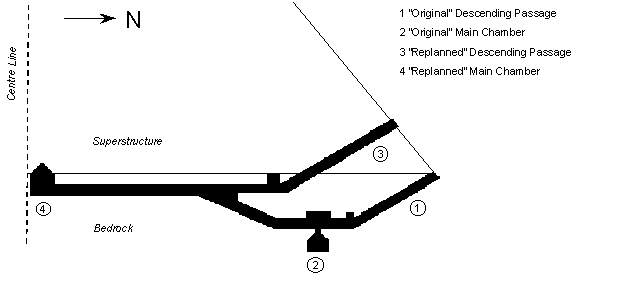
Figure 3: The Second Pyramid in Profile
There are those who suggest that the lower chamber is merely a "serdab", comparing it to the Queen's Chamber in the Great Pyramid. This could then be used to suggest there was no replan. However there is no precedent for a serdab or any other chamber lying so far away from the centre point of its pyramid. And even more critical to this argument is the existence of a recess cut into the east wall of the original passage, the layout of which I have reproduced in Figure 4. I have encountered no explanation for this in the work of Egyptologists, but of course there would be one very good reason for its existence - it was needed to manoeuvre a coffer around the corner and into the chamber. We can see from the figure that in fact this would be impossible without the recess. And we should remember that all the other chambers in the Giza Pyramids (with the exception of the Subterranean Chamber in the Great Pyramid which is a special case anyway) at least butt up to ground level so that their coffers could be placed in situ during construction without being carried down passages. This is the case with the "replanned" main chamber of the Second Pyramid. However the "original" main chamber is entirely carved from the subterranean bedrock, so the descending passage had to be used.
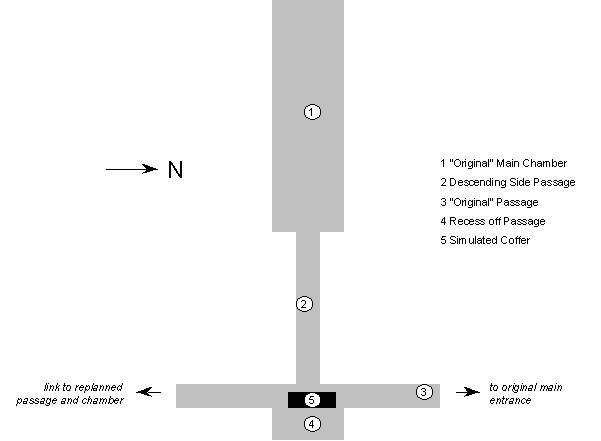
Figure 4: The Original Main Chamber in the Second Pyramid from Above
Furthermore, if we consult Edwards again, he is in little doubt:[v]
...the ["original"] chamber is situated very near the entrance to the pyramid and the entrance itself lies beyond the limits of the superstructure. In other contemporary pyramids, the tomb-chamber is located approximately beneath the apex and the entrance is situated in the northern face. If, however, it be supposed that, when the chamber and corridor were constructed, it was planned to build the pyramid some 200 feet further north, both the chamber and the entrance would have occupied their customary positions. A possible reason for the change in plan was the discovery of a suitable rock foundation for the causeway concealed beneath the sand on a line south of the one originally chosen.
He therefore supports the replanning argument for the Second Pyramid as well, although he does not consider at all the possibility that the pyramid may have originally been considerably smaller rather than just repositioned. He, like others, finds the fact that the two passage systems were internally linked something of an enigma in a replanning context, and rejects, as do I, the argument that it allowed the coffer to be transported from the lower to the upper chamber. One suggestion is that it is not impossible that there was a ventilation purpose to this linkage, as can be at least partly argued for the "well shaft" in the Great Pyramid. Whatever its purpose, I do not feel that it essentially undermines the replanning argument which, above all, is arguably the most valid explanation for the offset lower chamber once the evidence of the Third Pyramid is evinced to indicate that significant replanning was clearly not an unusual occurrence.
We should also consider which is the more likely scenario for the Second Pyramid - wholesale repositioning or a huge increase in size? I do not find Edwards' suggestion regarding the foundations for the causeway particularly convincing. On the other hand, there is every reason to suppose that Khafre might have started out with only limited pyramid ambitions. His predecessor, Djedefre, had forsaken the Giza Plateau to build his pyramid at Abu Roash to the north. Since this edifice was clearly unfinished, and he only ruled for eight years, it is assumed that his life ended ahead of time - indeed perhaps even deliberately terminated in a coup by Khafre himself. This all tends to suggest political mixed in with religious upheaval.[vi] Snce Khafre clearly knew from his own actions that there was no guarantee that his pyramid would be completed in appropriate style by his successor, and was initially uncertain about how long he might last, there would have been every reason for him to start small and then become more ambitious once his tenure of the throne looked more secure.
As for Menkaure and the Third Pyramid, not only may he have had an even more jaundiced view of the political climate, but we know that he died even before his relatively small complex was finished. At the very least his valley temple and causeway - excavated by George Reisner in the early 1900's - were found to have been hastily completed using mud bricks, his early death from whatever cause suggesting that he was right to be generally conservative with his pyramid plans.
I have reconstructed the various possible configurations of original and replanned layouts in Figure 5. It seems inconceivable that such large-scale replanning, to the extent that the Second Pyramid was increased in base area by as much as nine times or shifted a long way south, and the Third Pyramid quadrupled in base area, after construction had begun, could have occurred on the Plateau if the representation of the relative size and position of Orion’s belt stars was so important from the outset as part of a master plan. In particular, we can see that:
a) if the Second Pyramid was originally positioned considerably to the north the layout would have destroyed the 45 degree diagonal relationship between it and the Great Pyramid which is so essential to Robert Bauval's sky maps of 10,500 BC
b) if the Second Pyramid was originally significantly smaller then it would be far closer to the Great Pyramid than to the Third, thereby totally failing to replicate the relatively equidistant relationship between the three belt stars of Orion
c) when the Third Pyramid was originally planned to be much smaller, the already huge discrepancy in its size relative to that of Mintaka would have been even more exaggerated.
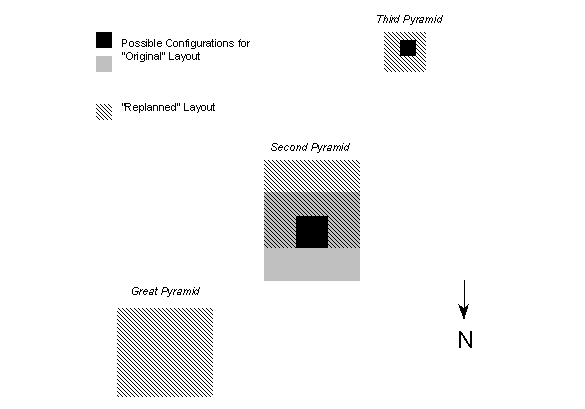
Figure 5: The Original and Replanned Layouts of the Giza Pyramids
Conclusion
I would argue that the combination of the relative sizing and the replanning arguments provide incontrovertible proof that the Orion-Giza Correlation Theory is fundamentally flawed. Indeed in my view the replanning argument contains a broader implication for anyone who suggests that the whole Plateau was laid out to express sacred geometric knowledge, or to act as a decodable map to locate further secrets or even the so-called Hall of Records itself. However I welcome correspondence from any supporters of these theories who can find fault with my own line of reasoning.
Notes
[i] Nor is it in the photograph reproduced in Bauval and Gilbert, The Orion Mystery, Plate 8. Meanwhile, although I am no expert, the highly magnified shot reproduced in ibid., Plate 7, appears to be distorting the relative magnitudes due to some sort of reflective “halo” effect.
[ii] By contrast, the “absolute magnitude” attempts to take this into account, so a larger star which was further away might have the same visual but a larger absolute magnitude. Meanwhile the “photographic magnitude” can differ again because the eye deals with the colours of the spectrum differently from a lens, and stars have different colours dependent on their temperature. However this potential distortion of photographic images as against human vision can in this case be discounted because the three belt stars have a very similar colour index—varying between minus 0.19 and minus 0.22. We should also note that in the Orion constellation only Betelgeuse has a magnitude which varies significantly over time; and further that the two outer stars are “doubles”.
iii] Data taken from the Bright Star Catalogue.
[iv] Edwards, The Pyramids of Egypt, Ebury Press, 1972, Chapter Four, pp. 119-20.
[v] Ibid., Chapter Four, pp. 113-4.
[vi] As an example of politics, celebrated Egyptologist Selim Hassan suggests that Djedefre was Khufu’s son by a Libyan wife, and this caused succession problems (Hassan, The Sphinx: Its History in the Light of Recent Excavations, Cairo Government Press, 1949, p. 91, Note 1). Alternatively from a religious perspective, Djedef-re was the first Fourth Dynasty king to place significant emphasis on the re-emerging Sun-cult by adopting the title “son of ra”.
